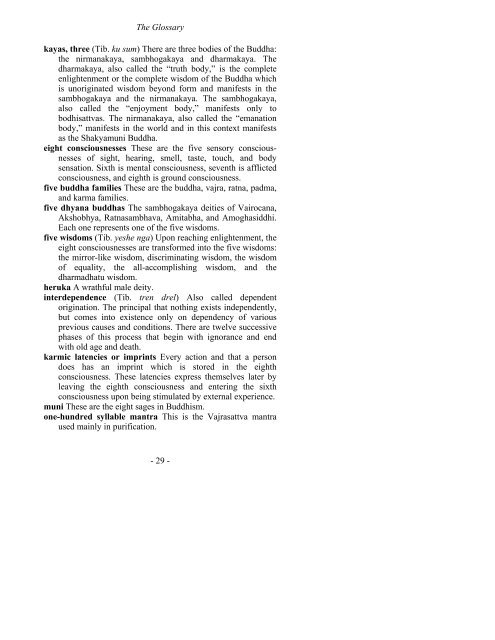bardo
bardo
bardo
Create successful ePaper yourself
Turn your PDF publications into a flip-book with our unique Google optimized e-Paper software.
The Glossary<br />
kayas, three (Tib. ku sum) There are three bodies of the Buddha:<br />
the nirmanakaya, sambhogakaya and dharmakaya. The<br />
dharmakaya, also called the “truth body,” is the complete<br />
enlightenment or the complete wisdom of the Buddha which<br />
is unoriginated wisdom beyond form and manifests in the<br />
sambhogakaya and the nirmanakaya. The sambhogakaya,<br />
also called the “enjoyment body,” manifests only to<br />
bodhisattvas. The nirmanakaya, also called the “emanation<br />
body,” manifests in the world and in this context manifests<br />
as the Shakyamuni Buddha.<br />
eight consciousnesses These are the five sensory consciousnesses<br />
of sight, hearing, smell, taste, touch, and body<br />
sensation. Sixth is mental consciousness, seventh is afflicted<br />
consciousness, and eighth is ground consciousness.<br />
five buddha families These are the buddha, vajra, ratna, padma,<br />
and karma families.<br />
five dhyana buddhas The sambhogakaya deities of Vairocana,<br />
Akshobhya, Ratnasambhava, Amitabha, and Amoghasiddhi.<br />
Each one represents one of the five wisdoms.<br />
five wisdoms (Tib. yeshe nga) Upon reaching enlightenment, the<br />
eight consciousnesses are transformed into the five wisdoms:<br />
the mirror-like wisdom, discriminating wisdom, the wisdom<br />
of equality, the all-accomplishing wisdom, and the<br />
dharmadhatu wisdom.<br />
heruka A wrathful male deity.<br />
interdependence (Tib. tren drel) Also called dependent<br />
origination. The principal that nothing exists independently,<br />
but comes into existence only on dependency of various<br />
previous causes and conditions. There are twelve successive<br />
phases of this process that begin with ignorance and end<br />
with old age and death.<br />
karmic latencies or imprints Every action and that a person<br />
does has an imprint which is stored in the eighth<br />
consciousness. These latencies express themselves later by<br />
leaving the eighth consciousness and entering the sixth<br />
consciousness upon being stimulated by external experience.<br />
muni These are the eight sages in Buddhism.<br />
one-hundred syllable mantra This is the Vajrasattva mantra<br />
used mainly in purification.<br />
- 29 -


